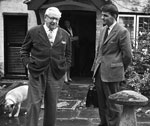Published: London, Wednesday, April 25,
2007 H-NET BOOK REVIEW Published by [email protected] (March, 2007) Paul Addison and Jeremy A. Crang, eds. Firestorm: The Bombing of Dresden, 1945. Chicago: Ivan R. Dee, 2006. x + 260 pp. Maps, notes, index. $16.95 (paper), ISBN 978-1-56663-713-8. Reviewed for H-German by Andy Spencer, Department of Germanic Languages and Literatures, Ohio State University. Dresden Redux TOWARDS the end of the tenth and final contribution to this collection of essays, derived initially from a colloquium hosted by Edinburgh University in May 2003, co-editor Paul Addison notes that "the debate over Dresden is likely to end in a stalemate" (p. 217). By this he means that some will always defend the actions of the Allied air commanders who ordered the Dresden raids in February 1945, just as some will always condemn them. In his contribution to the present volume, Donald Bloxham succinctly fleshes out this state of affairs, writing of the other essays collected here:
I cite Bloxham at length as he condenses much better than
I ever could, but also because, in a prefatory remark to the
above summation, he claims, with a somewhat unfortunate turn
of phrase, that the essays have "exploded some of the more
prevalent myths" connected with the raids. Here, I believe,
Bloxham unwittingly puts his finger on a structuring
principle of the book that does not bear up particularly
well under scrutiny. Surely the "explosions" have long since
resounded, and while the various contributors marshal their
evidence effectively, they actually do little more than
trail in the wake of Jörg Friedrich on the one
hand and Frederick Taylor Conceived as a wide-ranging overview of the historical event that was the bombing of Dresden, or "Dresden" as Bloxham coins the complex of events (p. 181), the chapters proceed from an investigation into strategic bombing before Dresden by Strachan, to an extremely detailed account of the planning and execution of the raids by Sebastian Cox, to Sönke Neitzel's view of life on the ground. Essays follow on wartime reactions to the raids in Britain, the United States and Germany by Tami Davis Biddle; on postwar opinions by Richard Overy; and on postwar reconstruction by Nicola Lambourne.
Although the preface denies that the book as a whole represents "a particular school of thought" (p. x), the points of contention are few and relatively minor. An exception to this general mood comes when Neitzel strays from the Taylor narrative to claim that Dresden's industrial plants "played no significant role in German war industry at this stage of the war" (p. 76), an assertion noticeably at odds with an earlier one made by Sebastian Cox: "Dresden was a major contributor to the Reich's war effort, and those who would deny or downplay such importance are factually in error" (p. 56).  Photo: In 1962 David Irving obtained from the Master Bomber in the Dresden raid, Wing Cdr Maurice Smith, the original target map used for the raid. The railroad station (visible at bottom center) and railroad bridge were omitted from the sector of attack. From David Irving "Apocalypse 1945: the Destruction of Dresden". (Order this book) Cox relies on Taylor to argue that "five weeks after the raid two of the four tracks across the Elbe rail bridge were still blocked" (p. 58), whereas Neitzel tells the reader that "the railway lines were out of action for only a few days" (p. 76). Despite these differences, Cox's view, that the raids "however awful, did have a strategic purpose and rationale and were not merely wanton" (p. 61), is generally accepted by all contributors, with only minor reservations. The degree to which the contributors concur is also mirrored in the overlapping of evidence proffered. Although the chapters would appear dedicated to discrete aspects of "Dresden," the book reveals a general reliance on a core of materials and talking points and thus a good deal of repetition.  Winston Churchill's aspersion (document above, from David Irving: "Churchill's War", vol. iii: "The Sundered Dream") that the raids represented "a serious query against the conduct of Allied bombing" is cited no fewer than four times by Biddle, Overy and Addison, twice; U.S. Air Force Commander-in-Chief Henry Arnold's admonition, "We must not get soft. War must be destructive and to a certain extent inhuman and ruthless" is cited twice as well, by Biddle and Overy. The debate as to the actual number of casualties is repeated three times, each time with a similar conclusion: Cox is of the opinion that it is "highly unlikely that the final death toll exceeded 35,000 to 40,000" (p. 51); Neitzel tends toward the lower end, but ultimately accepts Taylor's "compromise" of "25,000-40,000 deaths" (p. 75); Overy tells us that "latest estimates suggest a figure of 25,000 in total" (p. 137). That David Irving, author of The Destruction of Dresden (1963) should figure in five of the contributions is not surprising; that Overy should use a particular quote of his twice in the same essay, however, is to belabor the case.
The two essays not directly concerned with the historiography of the raids, Crang's on Klemperer and Russell's on the Dresden Trust, do not fit easily in the volume. Crang dutifully summarizes Klemperer's diaries without adding to our knowledge, somewhat compromising the lot of the materialist historian elsewhere in the volume by calling the raids "something of a miracle" for Klemperer, "an act of divine intervention" (p. 78). The author also avails himself of the obligatory reference to Dante's Inferno, as does Cox (pp. 88, 48). Russell's essay on the Dresden Trust, misleadingly entitled "Why Dresden Matters," is one long advertisement for an undoubtedly reputable organization, but how this paean fits in the context of the other contributions is unclear. Nicola Lambourne does her best to smooth the way for Russell by ending her essay on postwar reconstruction with a stirring defense of the rebuilding of the Frauenkirche, which nonetheless pales besides Russell's ecstatic prose. He concludes his essay with the affirmation that "Dresden's beacon is indeed shining brightly," following a litany of the city's recent cultural accomplishments. One such is the classification of Dresden as a "UNESCO World Heritage Site." This declaration took me back to last summer, when UNESCO threatened to withdraw its seal of approval if the planned construction of a bridge across the Elbe went ahead. Aware of the threat, but more concerned about the commute home, the good citizens of Dresden voted for the bridge in a referendum. Russell's rose-tinted view of Dresden, "a name to conjure with," could run into problems on the ground. Fortunately, Russell's piece is followed by the most
engaging essay of the book, Bloxham's discussion of
"Dresden" as a war crime. Right:
The book that started it all in 1963.
Notes [1]. Jörg Friedrich, Der Brand. Deutschland im Bombenkrieg 1940-1945 (Munich: Propyläen Verlag, 2002), translated as The Fire. The Bombing of Germany, 1940-1945 (New York: Columbia University Press, 2006); Frederick Taylor, Dresden: 13 February 1945 (New York: Harper Collins, 2004). [2]. Michael Burleigh, "Mission Accomplished" The Guardian, February 7, 2004, available online at http://books.guardian.co.uk/reviews/history/0,6121,1142632,00.html (accessed March 1, 2007). Copyright © 2007 by H-Net, all rights reserved.
|


 Damage
to the city after one night of terror bombing, photographed
March 1945
Damage
to the city after one night of terror bombing, photographed
March 1945
